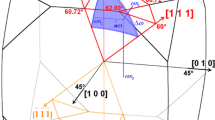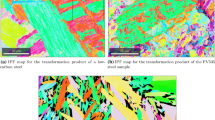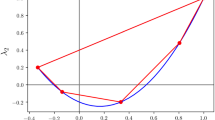Abstract
To be useful in numerical simulations of e.g. deformation processes, EBSD datasets of crystallographic orientations have to be downsized by several orders of magnitude yet preserving the orientation density function approximately. The objective is either to preserve the overall shape of the initially kernel estimated orientation density function and in particular its non-negativity, or to preserve the unbiased estimates of the first Fourier coefficients up to a given finite order. Methods are presented how to construct a much smaller set of weighted orientations such that their kernel density estimate approximates the initial estimate. To preserve its overall shape the de la Vallée Poussin kernel is applied as it is the only known non-negative kernel with a finite Fourier series expansion avoiding truncation errors. If the first Fourier coefficients are to be preserved the Dirichlet kernel applies as it is the only kernel providing unbiased estimates of the Fourier coefficients up to any given finite order. The weights are determined numerically by resolving a least squares or a maximum likelihood problem. Due to the linearity of kernel density estimation and the Fourier transform the approaches in spatial and spectral domain are related to each other in a unique complementary way. For an exemplary practical application we use a large EBSD dataset of about 80.000 orientations from a recrystallized low alloyed Zirconium sheet. Our methods reduce the size of the dataset by about \(99.75\,\%\) to the order of 200 weighted orientations supporting a secondary approximate distribution with a volume portion of crystallites oriented differently than initially of less than \(10\,\%\).








Similar content being viewed by others
References
Hielscher R (2013) Kernel density estimation on the rotation group and its application to crystallographic texture analysis. J Multivariate Anal 119:119–143
Tikhovskiy I, Raabe D, Roters F (2007) Simulation of earing during deep drawing of an Al-3% Mg alloy (AA 5754) using a texture component crystal plasticity FEM. J Mater Process Technol 183:169–175
Knezevic M, Landry NW (2015) Procedures for reducing large datasets of crystal orientations using generalized spherical harmonics. Mech Mater 88:73–86
Eisenlohr P, Roters F (2008) Selecting sets of discrete orientations for accurate texture reconstruction. Comp Mater Sci 42:670–678
Bunge HJ (1982) Texture analysis in materials science: mathematical methods. Butterworths, London
Bozzolo N, Gerspach F, Sawina G, Wagner F (2007) Accuracy of orientation distribution function determination based on EBSD data: a case study of a recrystallized low alloyed Zr sheet. J Microsc 227:275–283
Bachmann F, Hielscher R, Schaeben H (2010) Texture analysis with MTEX -free and open source software toolbox. Solid State Phenom 160:63–68
Silverman BW (1986) Density estimation for statistics and data analysis. Chapman & Hall/CRC, London
Scott DW (2015) Multivariate density estimation: theory, practice, and visualization, 2nd edn. Wiley, New York
Wand MP, Jones MC (1995) Kernel smoothing. Chapman & Hall/CRC, London
Alexandre BT (2009) Introduction to nonparametric estimation. Springer, New York
Tsybakov A (2009) Introduction to nonparametric estimation. Springer, Berlin
Hall P, Watson GS, Cabrera J (1987) Kernel density estimation with spherical data. Biometrika 74:751–762
Schaeben H (1993) Towards statistics of crystal orientations in quantitative texture analysis. J Appl Cryst 26:112–121
Pelletier B (2005) Kernel density estimation on Riemannian manifolds. Statist Probab Lett 73:297–304
Rudin W (1991) Functional analysis, 2nd edn. McGrawHill, New York
Watson GS (1969) Density estimation by orthogonal series. Ann Math Statist 40:1496–1498
Hendriks H (1990) Nonparametric estimation of a probability density on a Riemannian manifold using Fourier expansion. Ann Statist 18:832–849
Berens H, Butzer PL, Pawelke S (1968) Limitierungsverfahren von Reihen mehrdimensionaler Kugelfunktionen und deren Saturationsverhalten. Publ RIMS, Kyoto Univ Ser A 4:201–268
Pawelke S (1972) Über die Approximationsordnung bei Kugelfunktionen und algebraischen Polynomen. Tohoku Math Journ 24:473–486
Butzer PL, Stens RL, Wehrens H (1979) Approximation by algebraic convolution integrals. In: Prolla JB (ed) Approximation theory and functional analysis. North Holland Publishing Comp, Amsterdam, pp 120–171
Freeden W, Gervens T, Schreiner M (1998) Constructive approximation on the sphere. Clarendon Press, Oxford
Butzer PL, Nessel RJ (1971) Fourier analysis and approximaation. Birkhäuser, Basel
Schaeben H (1997) A simple standard orientation density function: the hyperspherical de la Vallée Poussin kernel. Phys Stat Sol (B) 200:367–376
Schaeben H (1999) The de la Vallée Poussin standard orientation density function. Textures Microstruct 33:365–373
León CA, Massé J-C, Rivest L-P (2006) A statistical model for random rotations. J Multivariate Anal 97:412–430
Fengler MJ, Freeden W, Gutting M (2005) The spherical Bernstein wavelet. Schriften zur funktionalanalysis und geomathematik 20. TU Kaiserslautern, Kaiserslautern
Rudin W (1964) Principles of mathematical analysis, 2nd edn. McGraw-Hill, New York
Marron JS (1988) Automatic smoothing parameter selection: a survey. Empir Econ 13:187–208
Jones MC, Marron JS, Sheather SJ (1996) A brief survey of bandwidth selection for density estimation. J Am Stat Assoc 91:401–407. doi:10.2307/2291420
Habbema JDF, Hennans J, Van den Broek K (1974) A stepwise discrimination analysis program using density estimation. In: Bruckmann G (ed) COMPSTAT 1974, Proceedings in computational staristics. Physica-Verlag, Vienna, pp 101–110
Duin RPW (1976) On the choice of smoothing parameters of Parzen estimators of probability density functions. IEEE Trans Comput 25:1175–1179
Bowman AW (1984) An alternative method of cross-validation for the smoothing of density estimates. Biometrika 71:353–360
Press WH, Teukolsky SA, Vetterling WT, Flannery BP (2007) Numerical recipes: the art of scientific computing, 3rd edn. Cambridge University Press, Cambridge
Adams BL, Henrie A, Henrie B, Lyon M, Kalidindi SR, Garmestani H (2001) Microstructure-sensitive design of a compliant beam. J Mech Phys Solids 49:1639–1663
Bachmann F, Schaeben H (2015) Diminution of the sample size of individual orientation measurements approximately preserving the orientation density function. In: Schaeben H, Tolosana Delgado R, van den Boogaart KG, van den Boogaart R (eds) Proceedings of the 17 annual conference of the international association for mathematical geosciences, Freiberg, Germany, 7–10, Sept 2015, DVD ISBN 978-3-00-050337-5
Bachmann F, Fundenberger J-J, Schaeben H (2016) Weighted individual crystallographic orientations capturing a given orientation density function, THERMEC 2016, Graz, Austria, May 29–June 3, 2016
Acknowledgements
This communication is a largely extended update of a methodological contribution by the authors FB and HS to the 17th Annual Conference of the International Association for Mathematical Geosciences, held in Freiberg, Germany, Sep 7–10, 2015, published on a DVD Proceedings, ISBN 978-3-00-050337-5, available from International Association for Mathematical Geosciences, [36]. The example was orally presented by HS at the occasion of THERMEC’2016 in Graz, Austria, May 29–June 3, 2016, [37].
Author information
Authors and Affiliations
Corresponding author
Ethics declarations
Conflict of interest
The authors declare that they have no conflict of interest.
Rights and permissions
About this article
Cite this article
Schaeben, H., Bachmann, F. & Fundenberger, JJ. Construction of weighted crystallographic orientations capturing a given orientation density function. J Mater Sci 52, 2077–2090 (2017). https://doi.org/10.1007/s10853-016-0496-1
Received:
Accepted:
Published:
Issue Date:
DOI: https://doi.org/10.1007/s10853-016-0496-1




